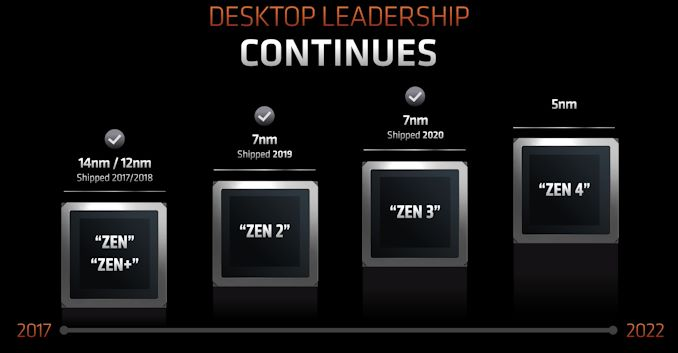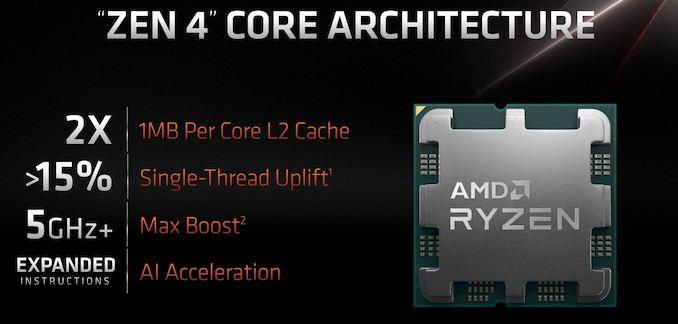
With the release of the Ryzen 6000 mobile processor range, AMD showed it was serious about performance-per-watt and gave the 12th-generation Intel laptop CPUs a run for their money even without the benefit of a hybrid architecture. It was a solid showing that really made us wonder what AMD’s newest CPU technology can do without the shackles of laptop power and thermal limits.
Now Dr. Lisa Su (AMD CEO) has officially unveiled the Ryzen 7000 series of CPUs. While we don’t get to see independent benchmarks or real-world tests yet, there’s more than enough in the juicy-detail department to chew on.
It’s Called Zen 4 and It’s 5nm
The Ryzen 7000 CPUs are officially using the Zen 4 architecture and are built on a 5nm process. The 12th-gen Intel chips are built using the Intel 7 process, but that’s a bit of marketing fluff since they are still being made using Intel’s ultra-refined 10nm process. Intel continues to struggle with the advancement of their CPU processes, which is why they are likely to start the road towards at least partial fabless production or maybe just buy up former fabless providers.

Of course, one of the reasons that AMD has been able to pull ahead here is that their chips aren’t unified under one process. While the CPU “chiplets” are 5nm, other components such as the iGPU, DDR5 controller, and PCIe 5 controller are based on a 6nm process. This offers a good mix of performance where it counts and costs saving where the impact won’t be felt. The “optimized” 5nm TSMC process these AMD chips are based on actually comes from smartphones, so we expect great things in the TDP department.
Amping Up and Caching In
The main reason AMD has been so relevant in recent years is the rapid improvement in IPC (Instructions Per Clock) compared to the competition. AMD had been struggling to match Intel CPU cores at the same clock speeds, but they made up for it by simply stuffing many more cores into the CPU package.
Then we reached the point where AMD CPUs matched or beat Intel’s products in terms of IPC and still offered more cores for the money. That’s likely the big push behind the revolutionary 120th-gen chips we’ve been playing with for a few months now.
AMD is making some big claims about Zen 4, saying that we’ll see a 15% improvement in per-thread performance and boost clocks in excess of 5Ghz.

One interesting detail about Zen 4 is that the per-core L2 cache allocation is being doubled. Every core will have 1MB of L2. There are no details about L3 cache amounts or whether we’ll see that fancy new 3D V-cache in consumer Zen 4 Chips.
Hotter Than Expected?
While the technology on paper suggests lower TDPs, the chipset specification for Zen 4’s AM5 socket calls for a nominal max TDP of 170W and a peak TDP of 230W. This doesn’t mean that the actual CPUs are going to run hotter than the Zen 3 models they replace, but clearly, AMD is giving itself headroom for something big and power-hungry. Perhaps a new Zen 4 Threadripper with core counts that look like a phone number?
Speaking of Chipsets...

On the motherboard side of the equation, interesting things are happening with Zen 4 and AM5. According to PC Gamer, there are no longer discrete chipsets for motherboard makers.
Instead, the motherboard chipset design is modular. The fundamental chipset unit forms the basis of the entry-level motherboards. The high-end motherboard models simply have two of these chip packages, doubling everything the single-chip offers.

So the X670 and B650 won’t differ in terms of fundamental technology, but only in the number of chipset units.
The Chip Lineup
The presentation by Dr. Su is a high-level look at products that are only set for release in the Fall of 2022, so we don’t know how the SKUs will break down into individual products. What we do know is that Zen 4 chips:
-
Will have up to 14 cores
-
Offer a minimum of 1x PCIe 5.9 M.2 slots.
-
Will have up to 14 20Gbps USB channels.
-
Support quad-channel DDR5
-
Support Wi-Fi 6E
When it comes to PCIe support from the chipsets, the B650 only offers 4.0, and 5.0 is optional for the X670 boards, at the discretion of board partners. X670E boards must have two x16 PCIe 5.0 slots.
That sounds a little disappointing, but there aren’t even any GPUs in this (and likely the next) generation that can saturate PCIe 4.0, so this is some long-term future-proofing. Either way, we can’t wait to get our hands on this new AMD silicon and see what sorts of value performance systems we can build.